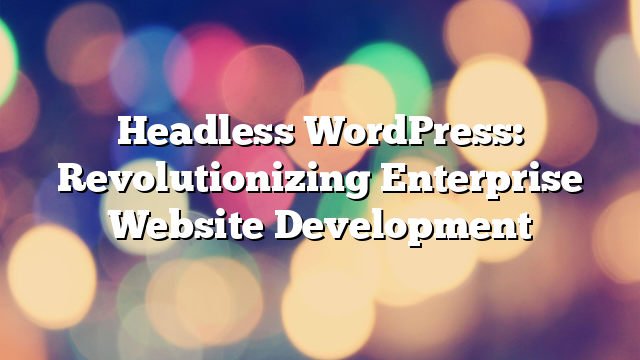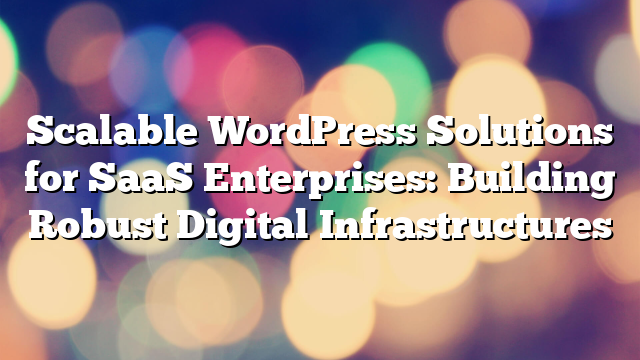Headless WordPress: Revolutionizing Enterprise Website Development
04.12.2024

As enterprises strive to deliver seamless user experiences and remain competitive in the digital space, traditional web development approaches often fall short. Enter **Headless WordPress**—a modern architecture that decouples the frontend and backend, offering unparalleled flexibility, scalability, and performance. In this article, we explore how Headless WordPress is revolutionizing enterprise website development and why it’s an ideal choice for forward-thinking organizations.
What is Headless WordPress?
In a traditional WordPress setup, the frontend (what users see) and the backend (where content is managed) are tightly integrated. Headless WordPress separates these two components. The backend remains WordPress, while the frontend is built using modern technologies like React, Angular, or Next.js. Communication between the two is facilitated by REST APIs or GraphQL.
Benefits of Headless WordPress for Enterprises
1. Enhanced Performance
By decoupling the frontend, Headless WordPress allows developers to optimize the user interface for speed and responsiveness. Technologies like static site generation (SSG) ensure pages load almost instantly, improving user experience and SEO rankings.
2. Scalability
Headless WordPress enables enterprises to handle high traffic volumes and complex site structures without compromising performance. The separation of concerns between the frontend and backend ensures seamless scalability.
3. Flexibility in Design
Developers are no longer restricted by WordPress themes. Instead, they can build fully customized frontends using modern frameworks, creating unique and interactive user experiences tailored to enterprise needs.
4. Improved Security
By decoupling the backend, the WordPress admin panel is hidden from public access, reducing vulnerabilities to attacks. Additionally, APIs can be secured with authentication tokens, enhancing overall security.
5. Omnichannel Delivery
Content created in WordPress can be delivered across multiple channels—websites, mobile apps, IoT devices, and more. This makes Headless WordPress an excellent choice for enterprises pursuing omnichannel strategies.
6. Future-Proof Architecture
With Headless WordPress, enterprises are not tied to a single frontend framework. This ensures adaptability to emerging technologies and future updates.
Use Cases for Headless WordPress
1. E-Commerce Platforms
Headless WordPress allows enterprises to create high-performing e-commerce websites that integrate seamlessly with platforms like WooCommerce. The decoupled frontend ensures faster load times and personalized shopping experiences.
2. Content-Driven Websites
For news portals, blogs, or knowledge bases, Headless WordPress offers the ability to deliver dynamic content efficiently while maintaining superior performance.
3. Multilingual and Multi-Region Websites
Headless WordPress simplifies the management of multilingual content and region-specific frontends, ensuring a localized experience for global audiences.
4. Mobile and Progressive Web Apps (PWAs)
Enterprises can use Headless WordPress as the backend for mobile applications or PWAs, ensuring consistent content delivery across all platforms.
5. Custom Web Applications
For businesses requiring unique web applications, Headless WordPress offers the flexibility to build custom frontends while leveraging WordPress’s robust backend capabilities.
Challenges of Implementing Headless WordPress
1. Increased Complexity
Headless WordPress requires expertise in both WordPress and modern frontend frameworks. Enterprises may need skilled developers to manage the integration and maintenance.
2. Dependency on APIs
APIs act as the bridge between the frontend and backend. Over-reliance on APIs can lead to performance bottlenecks if not optimized properly.
3. Higher Initial Costs
The development of a headless architecture can be more expensive upfront due to the need for custom frontends and specialized skills. However, the long-term benefits often outweigh these costs.
4. Maintenance Challenges
Managing separate systems for the frontend and backend requires efficient workflows and tools. Automated deployment pipelines and monitoring systems can simplify this process.
Best Practices for Headless WordPress Development
1. Choose the Right Frontend Framework
Select a framework that aligns with your enterprise goals. React-based frameworks like Next.js are popular choices for their performance and flexibility.
2. Optimize API Performance
Use caching, pagination, and efficient queries to minimize API calls and enhance performance. Consider GraphQL for more efficient data fetching.
3. Prioritize Security
Secure your APIs with authentication tokens, rate limiting, and HTTPS. Ensure regular updates to the WordPress backend to patch vulnerabilities.
4. Focus on UX/UI
Leverage the flexibility of Headless WordPress to create intuitive, responsive, and visually appealing user interfaces that align with your brand.
5. Use Scalable Hosting
Deploy your frontend and backend on hosting platforms that support scalability, such as Vercel, AWS, or Google Cloud. Use CDNs for global content delivery.
Conclusion
Headless WordPress is transforming enterprise website development by offering the perfect blend of flexibility, performance, and scalability. It empowers businesses to create unique user experiences while maintaining robust content management capabilities. Despite the challenges, the benefits make it a worthwhile investment for enterprises aiming to stay ahead in the digital landscape.
Ready to explore the potential of Headless WordPress for your enterprise? Contact AllWebDev today to discover how we can help you build a cutting-edge digital experience.



